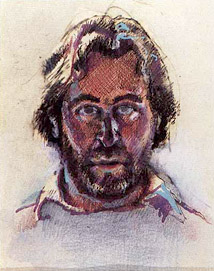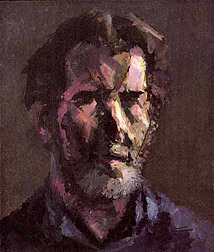The Portrait Works: Preface by Bill Hurrell
There's not a great deal of cricket in Canada, hardly any in Saskatchewan and none at all at Indian Head where I have my studio home, so each summer I come to England to get my fix. My two treats south of London's river are the Oval Test Match and my visit with Tom Phillips in his cramped, crammed studio.
We've been friends for many years from the time, when in France, we found ourselves two painters in a gaggle of semioticians and structuralists at a colloque on the novels of HWK Collam, that strange late flower of surrealism whose work we both so much admire. We disgraced ourselves by laughing at the jokes in the aged author's wryly ironic closing speech: we left Rouen together in a hurry.
I had however encountered Tom Phillips' work long before that in the late sixties, the days of CANADADA and the Image Bank of Toronto to which we both subscribed. To be more accurate I must confess that I thought there were at least two British artists called Tom Phillips since the works I saw were so divers. When at a concert of British music in the early seventies I heard a piece by a composer of the same name I made no connection either. To discover these were all the same person made me initially more rather than less confused. But just as visitors to a new city get to know it in bits and only much later find out how the bits join up, so I found in Tom Phillips' work the little roads that linked one fragment to another. In fact no artist leaves a better or more diligently helpful trail. He very much wants you to follow the pieces in what turns out to be, in the city of his enterprise, a deliberate paper-chase.
For one whose visits are usually a year apart Tom Phillips' studio is a totally unpredictable place, radically different each time according to the current obsession, though with constant elements. There has always been some portrait or other on the go as well as a work involving text of some sort, and of course the traces of continuity the Terminal Greys, A Humument, or the photographic piece 20 Sites n Years, all of which have been in progress for a couple of decades. Yet there is inevitable a completely new pot on the boil. Once the room was full of huge skins of vellum, some stretched on barbaric wooden stretchers, while on another occasion the scale was reversed when every available surfaced was covered in tiny models of art galleries on whose walls were placed miniature pictures (Small Galleries/Large Paintings). Another time the floor was a sea of scraps from the Boys's Own Paper, while on drawing-boards all over the room a whole show's worth of collages was being produced. In the last couple of years there have been more and more portraits in evidence as if spectators were assembling one by one to witness some event in the centre of the studio. This summer both sections of the studio were lined with faces and even the big ongoing Curriculum Vitae paintings were obscured by portraits propped up against them or perched precariously on their topmost edges.
Many of these people who stared from every surface at every angle were familiar to me from the great fiftieth birthday celebration match at the Oval when the Tom Phillips Eleven played the Rest of the Art World: virtually all the artist's friends were present for a long-to-be-remembered gala day. I recognised other heads, like those of Brian Eno or members of the Monty Python team and spotted some of the people that work at the Royal Academy, or at Franklin's café where the artist has treated me to a couple of excellent Sunday lunches. He himself was working when I arrived on a small self-portrait the same size as more than a dozen others that were strewn around and which he was beginning to put together in sets. I pointed to two pictures of a woman done in different styles since they seemed to have been deliberately placed together. 'Well, it's the same woman,' he explained, 'and she's sitting in the same chair and in the same house; but the first was done in 1962 and the second was done yesterday. Her name's Ann Parker and she just happened to be over from Geneva for a day or two so I waylaid her into coming here. Hers is almost the first portrait in the show so I wanted it to be one of the last as well, as if the whole exhibition were in brackets. Don't you think that's elegant? Says something about my life too: here I am over a quarter of a century later in the same studio painting the same friends..."
It was only then I noticed that, faintly indicated in the second picture is the image of the first as if on the wall behind Mrs. Parker (whom I now vaguely remember having met at that same splendid Cricket Match). The criss-crossing of the wallpaper vaguely scratched into the grey background reminded me of the format of the Terminal Grey pictures, so many of which must lie between the first portrait and its 1989 counterpart. This kind of experience is typical for me when looking at Tom Phillips' work. The whole Oeuvre is interwoven and paintings which seem to have nothing to do with each other turn out to be intimately connected or mutually referential.
Flipping through some photos of portraits over lunch, while my fellow artist quietly reflected on having just been beaten by me at ping-pong, I noticed again and again their rhymes and echoes. How, for example, the picture of Edward Lucie Smith contained the Terminal Grey that documents its own making; how the Dante Binding features, as well as a copy of the Inferno, a text drawing based on Dante; how the portrait of Jeremy King incorporates a work done from a postcard of the same place that the first of the long series of postcard paintings referred to, and how Adrian Mitchell's crowded world contains the jack-in-the-box Satie that featured in the artist's set designs for Mitchell's play. As each new outpost in Phillips' work is established it is joined to the network of other outposts by straight roads of quotation and reference or slyly winding paths of allusion. So it is with the portraits, which, though they at first seem out on a limb, soon find their place in the unified field of his oeuvre.
Though the portraits constitute not even a quarter of Phillips' output they form a substantial group which will perhaps in this exhibition establish its own coherence. I have only seen them in ones or twos over a long period but the overall impression that I have is of a growing assurance and a welcome tendency over the years to displace technical virtuosity with an opening up of feeling, to temper intellectual intensity with a more relaxed human warmth. Some of his sitters have in the past been made too intense as if beaming back to us through the subject's eyes all the may hours of staring that the artist himself has done. They have often proved difficult for the subject to live with, like the character in Collam's novel, Unhaunted Comma, who sold his portrait 'because', as he said, 'he could not bear to live on terms of such intimacy with himself'. They are potent things and the best of Tom Phillips' works in the genre seem charged with the sitter's personality.
Portraiture is very much alive in Britain today and almost all its leading painters are in some sense portraitists, whereas in my native Canada I cannot think of a single case (or even in France or Italy) of a serious artist in this field. The United States is beginning to find out that this is still one of the greatest challenges for a painter, to face nature in the form of one's own species, and culture in the shape of its real personifications. When Vellinger, in the same chapter of the novel I have already quoted from, tells Rima, his mistress, that he wants a portrait made of her rather than the photograph she offers, he explains that a photo 'is a memento, to be sure, but...it almost asserts that the person is not there. But the painted portrait is a presence detained forever, a departure indefinitely put off, an absence eternally negated'. It must have been an artist like Tom Phillips that he had in mind.
BILL HURRELL
Indian Head, Canada, 1989



